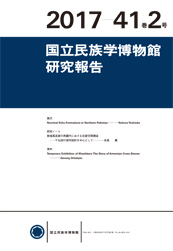Bulletin of the National Museum of Ethnology
Contents
- Articles
- Nominal Echo-Formations in Northern Pakistan
Yoshioka, Noboru - Research Notes
- Formation of Buddhist Cave Spaces in Western Wei Dynasty at Dunhuang Mogao Grottoes, China: Drawing Design of Thousand Buddha Motif
Suemori, Kaoru - Research Information
- Temporary Exhibition of Khachkars: The Story of Armenian Cross Stones
Orbelyan, Gevorg
Outline
Articles
Nominal Echo-Formations in Northern Pakistan
Noboru Yoshioka
In this study, I compare the morphophonological characteristics of the echo-formation processes of five languages spoken in northern Pakistan (Burushaski, Domaaki, Shina, Khowar, and Kalasha). The former three languages show identity- or similarity-avoidance in their echo reduplicants, while the latter two languages do not. This notable distinction between the groups matches their geographical distribution. The widely-used definitions of echo-formation do not include forms that exactly reduplicate the base word, but these forms have the same function as standard echo-words. Therefore, I advocate that the definition of echo-formation should be changed to include these forms in order to facilitate further study of the phenomenon.
Key Words:echo-word, identity avoidance, fixed segment, Burushaski, Khowar
Research Notes
Formation of Buddhist Cave Spaces in Western Wei Dynasty at Dunhuang Mogao Grottoes, China: Drawing Design of Thousand Buddha Motif
Kaoru Suemori
During the Western Wei dynasty (535–556 C.E.) in the Mogao Grottoes, several images and styles originating from China were introduced to the cave art, such as Chinese style clothing and traditional motifs from ancient China. Many studies have focused on the historical or ideological background of these arts, especially on Cave 285 of which the statue and murals indicate a strong influence from Chinese culture. On the other hand, many elements were derived from before the Western Wei dynasty. One of the derived elements is the Thousand Buddha motif, which repeats rows of seated Buddha figures with a regular coloring pattern. To understand the characteristics of the cave construction in the Western Wei dynasty, it is significant to understand how the Buddhist cave spaces were formed by both newly introduced elements and elements derived from older origins. The wide internal spaces of Cave 248, Cave 249 and Cave 288, which were assumed to have been constructed in the Western Wei dynasty, are decorated by the Thousand Buddha motif. This paper reveals the functions of the Thousand Buddha motif depicted in these three caves through analyzing the formation of the caves such as the cave structure, allocation of the statue and murals, and the drawing design of the Thousand Buddha motif. This paper also indicates the concept of cave construction in the Western Wei dynasty as well as the characteristics of the groups engaged in constructing the caves in this period.
Key Words:Chinese Buddhist Art, Dunhuang Mogao Grottoes, Western Wei, Cave Space Formation, Drawing design of Thousand Buddha motif
Research Information
Temporary Exhibition of Khachkars: The Story of Armenian Cross Stones
Special Exhibition at National Museum of Ethnology, Osaka, Japan September 29–October 11, 2016
Gevorg Orbelyan
This paper presents discussion of a special temporary exhibition in Minpaku, Japan held during September 29–October 11, 2016. The exhibition, “The Story of Khachkar: Armenian Cross Stones,” introduces and explains cultural and spiritual aspects of Armenia and Christianity to Japanese people. The process of planning and creating the museum exhibition are described.
This exhibition offers visitors an opportunity to gain objective knowledge about the Caucasus region, specifically Armenia. Its several museum objects and stories are displayed in a specific spatial arrangement to facilitate learning. The description of the exhibition compares new and conventional approaches and analyzes principles underlying specific characteristics of Christian culture through the exhibition.
After consideration of the role of special exhibitions in museums, a discussion is presented of how museum exhibitions communicate with visitors to deliver information simply, transmitting general knowledge to museum visitors without using advanced technology of media communications.
Key Words:special exhibition, Christianity in regional culture, Armenian cross stones, intercultural communication, Japanese “Taku-hon” and Armenian Khachkars
 2017-Vol. 41, No. 2
2017-Vol. 41, No. 2




